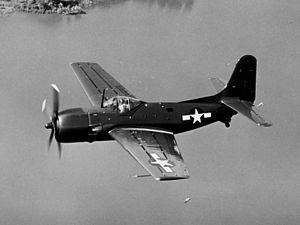Top speed 531 km/h Length 12 m | Wingspan 14 m | |
 | ||
Manufacturer Curtiss Aeroplane and Motor Company | ||
The Curtiss XBT2C was an experimental single-engined dive/torpedo bomber developed during World War II. It was based on the Curtiss XBTC single-seat dive/torpedo bomber, but used the less powerful Wright R-3350 radial engine, and could carry a second crew member in the rear fuselage. It was fitted with radar, which was carried in a pod under the starboard wing. Nine of ten projected aircraft were built. They were Curtiss' last type for the U.S. Navy. All were scrapped in the late 1940s.
Contents
Operators
Specifications (XBT2C-1)
Data from Curtiss Aircraft 1907–1947
General characteristics
Performance
Armament
References
Curtiss XBT2C Wikipedia(Text) CC BY-SA
